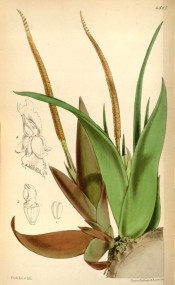Oberonia iridifolia Lindl.
Frost-tender epiphytic orchid with large, iris-like, fleshy leaves, brownish or copper-coloured when young, and a long flower spike composed of numerous minute flowers, yellowish in colour, the whole resembling a rats tail. [RHSD].
Horticultural & Botanical History
‘The present (Oberonia iridifolia) is, I believe, the largest of the known species, and is a native of Otaheita [Tahiti], where it was first detected by Sir Joseph Banks, (and whence our living plants were sent us by Mr. Bidwill), of Ceylon (Macrae), and of Nepal and Silhet, where it was found by Dr. Buchanan Hamilton and by Dr. Wallich, and where it flowers in the cold season. With us it first produced its singular flower spikes (more like a rat’s than a mouse’s tail) in January 1850. […] Being a native of the warm parts of India, this Orchid requires to be grown in the warm division of the Orchideous house. We have found it succeed when attached to a block of wood suspended near the glass, the plant being in an inclined position. A damp atmosphere is essential to it; still it appears to suffer if long exposed to any excess of moisture, especially during the winter season.’ [BM t.4517/1850]. Cymbidium iridifolium was introduced to Britain in 1837. [JD].
History at Camden Park
Listed in the 1850 and 1857 catalogues [O.9/1850]. Possessed by Macarthur since at least 1844 as it was sent to Lee of Hammersmith on 1st June of that year [REF]. It is possible that William Macarthur also received plants from Bidwill in Tahiti about the same time, although I have found no evidence of this.
Notes
Described in some texts as occurring widely in Australia where it bears greenish flowers. The Australian plant was described by Alan Cunningham: ‘On decayed trunks of trees in large masses, damp shaded woods on the Brisbane River. July 1828. This plant was alive at Kew.’ [BR Misc. p.34/1839]. This plant is probably Oberonia complanatum (A.Cunn.) M.A.Clem. & D.L.Jones, synonym Dendrobium complanatum A.Cunn. This is not recorded as synonymous with Oberonia iridifolia Lindl. by Jones. There is insufficient data to determine the exact identity of Macarthur’s plant but it could be the Australian species.
Cymbidium iridifolium Sw. ex Steud. (1840) = Oncidium iridifolium H.B. & K.
Published Jan 24, 2010 - 03:37 PM | Last updated Jan 24, 2010 - 03:44 PM
| Family | Orchidaceae |
|---|---|
| Category | |
| Region of origin | Asia and Pacific Islands |
| Synonyms |
|
| Common Name | Rats tail orchid |
| Name in the Camden Park Record |
Cymbidium iridifolium |
| Confidence level | medium |
